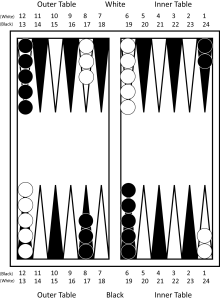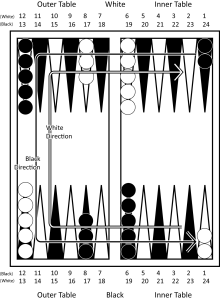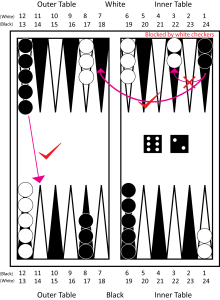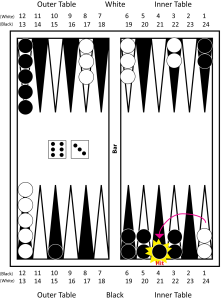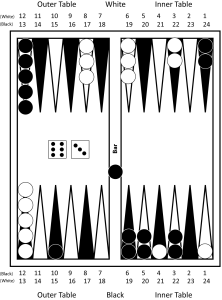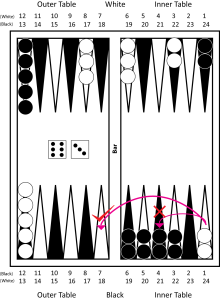Backgammon Rules
Terms
The round pieces used to play backgammon are called checkers. The triangular shapes found on the playing surfaces are called points. The board is divided in four parts: the opponent’s inner table (also called home board), the opponent’s outer table (also called outer board), the player’s outer table, and the player’s inner table. Having the checkers successfully making it to the end and leave the table is an action called “bearing off“. The game is played with four dice, two for each player, and one doubling cube. Some backgammon sets may come with dice cups, which help the players shake and roll the dice to make the numbers more random.
Goal
Backgammon is a race game. The goal of the game is to move all the checkers to the inner table and bear them all off (the checkers successfully make it out of the board). ALL of the checkers must be born off for the player to win, or the player may give up and surrender and let the other player win. The game is usually played with a set score of, say, 7 points. The first player to reach 7 points (which usually takes more than one game) wins the entire match. The set score is not limited to any particular number. The players determine the set score. Official backgammon tournaments are played to 13 points, with the final played to 25 points.
Set Up
There are 15 checkers for each player. The checkers are divided in colors: one player uses the dark checker (usually called the black checkers), and the other one uses the light checkers (usually called the white checkers).
Pips
The points are numbered in ascending order from the point that is the closest to bearing off to the furthest point. These numbers are also called “pips“. They indicate how many steps the players have to move their checkers to bear them off. The checkers always move to the lower numbered pips. The total number of pips (e.g. there are two black checkers in point 24, so these two add up to 48 pips) indicate which player is racing ahead in the game. The lower the total number of pips, the more the player is advancing.
Starting position
Having learned about pips, it would be easier to understand about the set up of the checkers. Each player starts the game with his / her checkers in such a manner:
- 2 checkers on Point #24
- = 2 x 24 = 48 pips
- 5 checkers on Point #13
- = 5 x 13 = 65 pips
- 3 checkers on Point #8
- = 3 x 8 = 24 pips
- 5 checkers on Point #6
- = 5 x 6 = 30 pips
- Total number of pips for each player: 167
Sitting opposite to each other, and counting the pips in the opposite direction to each other, but placing the checkers on the same equivalent points at the start of the game, the board becomes a mirror reflection of itself like shown below:
Starting the Game
Each player has two dice of his / her checker color. The player to make the first move is determined by the dice. Say there are Player A and Player B. Each player takes one die of his / her own and roll it. The color with the larger number begins the game. If Player A is the black color and he / she has the larger number, he / she begins the game. Then the second game is started by Player B. The third game is started by Player A, so on and so forth.
Once the player to make the starting move has been determined, the player rolls two dice to start moving the checkers.
Movement of the Checkers
The checkers are always moved from the furthest place, moving towards the player. Usually it is to the right side of the player, but the game can also be played in the opposite direction. To the players, the checkers move counter-clockwise, drawing only half a circle, or like a small letter “n” on its side. An illustration demonstrates this:
The checkers always stay on the points regardless of the color of the point. The points are colored alternatively for the purpose of counting pips more easily, and for aesthetics. The length of the point is usually 5 checkers long, but each point can accommodate an infinite number of checkers. This is usually done by placing the checkers on top of each other when there are more than 5 checkers.
Dice and Checker Movement
The two dice held by each player are rolled before a move is made. The number of points a checker can cross is determined by the dice. For example, if the player rolled 2-6, the checker can move two points, or six points, or both, by moving 2 points or 6 points first. The checkers must land on an open point, which means a point that is not blocked by the opponent’s checkers.
The player must always make the checker land on the point indicated by the dice. If the point is blocked by the opponent on the second point, then the player cannot move 2 points first. The player must move 6 points, then 2 points. The checkers cannot rest on the points in between.
Once the dice are rolled, ALL the moves provided by the dice must be performed wherever possible. If there is no possible movement according to the numbers on the dice, then the turn is given up and the opponent makes the next move. If only one of the two numbers on the dice is possible, then the player is obliged to make that move, and then it would the opponent’s turn.
If a player rolls doubles can play the roll as if there were four dice. If a player rolls 6-6, then he / she can move the checkers 6 points 4 times. This is true for a roll of 1-1, 2-2, 3-3, 4-4, 5-5, and 6-6.
Block and Hit
Players can capture (hit) the opponent’s checkers. To capture a checker, two conditions must apply:
- The target point must only hold one checker (this situation is called a blot)
- The number(s) of the dice allow the capturing checker to hit the target checker
The target checker must be alone, because having two or more checkers on one point blocks the opponent’s move. The hit checker is moved to the bar at the center of the board. With checker(s) on the bar, the player must first attempt to enter into the opponent’s inner table (move the checker out of the bar). If all possible moves out of the bar are blocked by the opponent, the player has to give up his / her turn and let the opponent play on until the bar has none of his / her checker.
A checker is therefore vulnerable to capture when alone on a point, and strategically advantageous and safe when there are other checkers on the same point.
Using two or more checkers on one point to block the opponent’s move will work only when the opponent moves to the point of block. Any block in between the opponent’s starting point and target point will not work on the opponent.
The below shows a situation where the black checkers strategically blocks many possible moves of the white checkers.
Bearing Off
Bearing off may occur once all the 15 checkers are on the inner table of the player. When bearing off, the player must confine to the numbers of the roll. If there is a checker on point #6, and the player rolls 5-2, the checker must be moved 5 points first, because 5 points are not enough to bear the checker off the inner board. Then the checker may use the number 2 to bear off. If a checker is on point #3 and another checker is on point #4, and the player throws 3-3, then the checker on point #3 may be born off immediately, but the checker on point #4 is moved to point #1, and then born off.
If all checkers are on points less than the numbers of the roll, then the player may bear off the checkers according to the number of moves allowed by the dice. If 5 checkers are all on point #1, a roll of 6-2 allows the player to bear off two checkers. A roll of 2-2 allows the player to bear off 4 checkers, so on and so forth.
Should the player who is bearing off be hit by the opponent, the player must first move the hit checker from the bar in the next move. Having one or more checkers outside of the player’s inner board means the player cannot bear off. The player must first try and move the checker back to the inner board before bearing off any more checkers.
Doubling Cube
Your backgammon set is most likely equipped with 5 cubes – four dice and one large cube you’ve probably never seen elsewhere. The doubling cube has 6 sides like a dice, each with a doubling number: 2, 4, 8, 16, 32, and 64. A doubling cube can be offered by any player at any time of the game. When offered, the opponent has to decide whether or not to accept the offer. If declined, the opponent immediately loses the game, and the player wins 1 point. If accepted, then whoever wins, the point is doubled. The doubling cube may be offered by any side at any time for any number of times. If the doubling cube is redoubled twice (three offerings), the winner would get the 8 times the point he / she would otherwise gain. The stake is higher with each offer of doubling cube. It is offered by the player when the player has confidence of victory.
Gammon and Backgammon
Gammon
If a player loses the game and has not born off any of his / her checkers, he / she is gammoned, and loses 2 points if without double (doubling cube), or loses twice the value shown on the doubling cube.
Backgammon
If the player loses the game and has one or more checkers on the bar or in the opponent’s inner table, then the player is backgammoned, losing 3 points if without double, or loses three times the value shown on the doubling cube.
Normal loss
If the loser has one or more checkers born off, the winner wins 1 point, or wins according to the value shown on the doubling cube.


